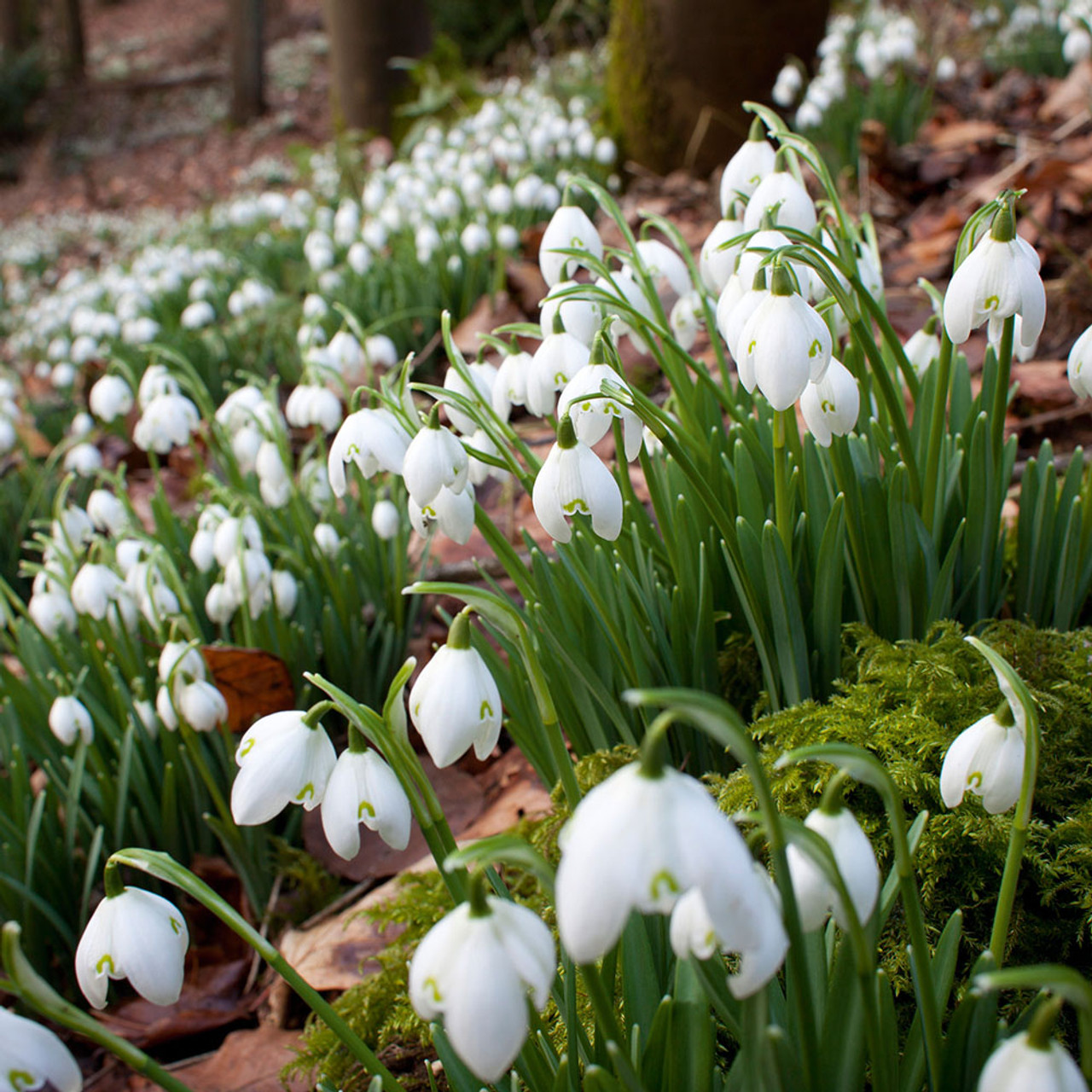As winter begins to loosen its grip, Snowdrops push through the cold earth like delicate messengers of hope. Their nodding white blooms appear when little else is awake, sometimes even through the snow, making them one of the earliest flowers to bloom.
But their charm isn’t just seasonal. Snowdrops offer gardeners a symbol of renewal, purity, and quiet resilience. These humble bulbs are small in stature but powerful in emotional presence — a reminder that beauty often arrives softly.

Portrait of the Snowdrop
Snowdrop (Galanthus spp.) is a small bulbous perennial in the Amaryllidaceae family, best known for its dainty, white bell-shaped flowers that bloom in late winter to early spring.
- Type: Bulbous perennial
- Family: Amaryllidaceae
- Common Names: Snowdrop, Galanthus
Foliage and Form
Snowdrops form clumps of narrow, grass-like leaves and small, pendulous flowers that hang gently from slender stems.
- Height: 7–15 cm (3–6 in)
- Spread: 5–10 cm (2–4 in)
- Growth Habit: Clumping, naturalizes over time
Blooms and Fragrance
Their delicate blooms are white with subtle green markings, nodding like lanterns in the wind.
- Bloom Time: Late winter to early spring
- Color: White with green accents
- Fragrance: Light, honey-like (some species)
The Right Time to Plant, Prune, and Enjoy Snowdrop
| Month | Planting | Flowering | Pruning |
|---|---|---|---|
| January | ❌ | ✅ In mild zones | ❌ |
| February | ❌ | ✅ Peak bloom | ❌ |
| March | ❌ | ✅ Final weeks | ✅ Remove spent blooms |
| April | ❌ | ❌ | ✅ Let foliage die back naturally |
| May | ❌ | ❌ | ✅ Cut dead foliage |
| June | ✅ In the green (best time) | ❌ | ❌ |
| July | ❌ | ❌ | ❌ |
| August | ✅ Dormant bulbs | ❌ | ❌ |
| September | ✅ Dormant bulbs | ❌ | ❌ |
| October | ✅ Finish planting bulbs | ❌ | ❌ |
| November | ❌ | ❌ | ❌ |
| December | ❌ | ✅ In warm climates | ❌ |
✅ = Recommended ❌ = Not advised
Watering, Sunlight, and Environment for Snowdrop
Watering
Snowdrops prefer consistently moist soil during their growing season. Once dormant, they need little water.
- When to Water: During growth and bloom (winter/spring)
- How Much: Light but regular watering
- Watch out for: Overwatering during dormancy
Sunlight
These flowers do well under deciduous trees, enjoying full sun in winter and dappled shade in summer.
- Ideal Exposure: Full sun to partial shade
- Shady Sites: Tolerated, but may reduce flowering
- Full Sun in Summer: Not ideal — they prefer protection
Indoor vs Outdoor
Snowdrops are happiest naturalized in gardens or woodland-style settings. They don’t thrive indoors for long.
- Best Location: Borders, under trees, in grassy lawns
- Avoid: Growing as houseplants or in hot, dry sites
Temperature
They are cold-hardy, and even snow won’t stop them from blooming.
- Optimal Range: –5°C to 15°C (23–59°F)
- Hardiness Zones: USDA 3–8
- Protection Tip: No special winter care needed
Ideal Soil Conditions for Growing Snowdrops
| Soil Feature | Optimal Condition | Why It Matters |
|---|---|---|
| Soil Type | Humus-rich loam or clay loam | Holds moisture but drains well |
| Texture | Loose, fine | Helps bulbs push through easily |
| Drainage | Moist but not soggy | Prevents bulb rot |
| Moisture | Consistent in winter/spring | Supports bloom and foliage health |
| Soil pH | Neutral to slightly alkaline (6.5–7.5) | Promotes bulb development |
| Fertility | Moderate | Too rich may promote more foliage than flowers |
Common Problems & Solutions
| Issue 🐾 | Symptoms 🔍 | Solutions 🛠️ |
|---|---|---|
| Bulb Rot 💧 | No emergence, mushy bulbs | Improve drainage, avoid soggy soil |
| Poor Blooming 🌱 | Lots of leaves, few flowers | Divide overcrowded clumps every few years |
| Pests 🐀 | Rodents digging bulbs | Use mesh or plant among deterrent species |
| Leaf Tip Browning 🍂 | Early die-back | Normal; allow leaves to wither naturally |
| Disappearance ❓ | No return the next year | Mark sites and avoid disturbing during dormancy |
Though modest in size, Snowdrops make a majestic seasonal statement. They signal the changing season and light the way toward spring. Plant them once, and they will return year after year with more blooms, offering a peaceful, natural beauty that feels both ancient and alive.